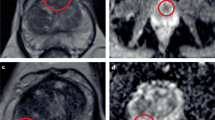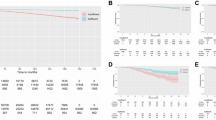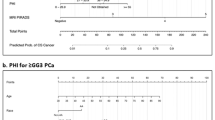Abstract
Background:
Our goal was to compare the ability of active surveillance (AS) criteria and preoperative nomograms to identify patients with pathologically low-risk prostate cancer.
Methods:
The study cohort consisted of 402 radical prostatectomy patients with Gleason 6 prostate cancer on at least 10-core biopsy. In this group, we analyzed the ability of Kattan and Truong nomograms to select patients with Gleason 3+3 or 3+4 organ-confined prostate cancer, and compared it with that of AS criteria of John Hopkins (JH) and University of California at San Francisco (UCSF) medical centers, and Prostate Cancer Research International: Active Surveillance (PRIAS) study. The performance of each tool was evaluated with respect to discrimination and predictive accuracy.
Results:
About 30% of patients were upgraded and 8% were upstaged in the final pathology. The nomograms demonstrated slightly higher discrimination in detecting organ-confined Gleason 3+3 and 3+4 disease. The predictive accuracy of the nomograms in selecting patients with low-grade organ-confined prostate cancer was superior to that of JH and UCSF criteria but not to PRIAS criteria. Furthermore, the nomograms were unable to select larger subgroups of patients with the same prevalence of Gleason 3+3 organ-confined prostate cancer as in men who met the PRIAS criteria. No difference was seen between the studied nomograms and AS criteria in their ability to identify patients with Gleason 3+4 organ-confined prostate cancer.
Conclusions:
PRIAS criteria demonstrate optimal balance between sensitivity and specificity and are not inferior to the available pathological nomograms in selecting patients with low-grade organ-confined prostate cancer.
This is a preview of subscription content, access via your institution
Access options
Subscribe to this journal
Receive 4 print issues and online access
$259.00 per year
only $64.75 per issue
Buy this article
- Purchase on Springer Link
- Instant access to full article PDF
Prices may be subject to local taxes which are calculated during checkout

Similar content being viewed by others
References
Eggener SE, Badani K, Barocas DA, Barrisford GW, Cheng JS, Chin AI et al. Gleason 6 prostate cancer: translating biology into population health. J Urol 2015; 194: 626–634.
Loeb S, Bruinsma SM, Nicholson J, Briganti A, Pickles T, Kakehi Y et al. Active surveillance for prostate cancer: a systematic review of clinicopathologic variables and biomarkers for risk stratification. Eur Urol 2015; 67: 619–626.
Caras RJ, Sterbis JR . Prostate cancer nomograms: a review of their use in cancer detection and treatment. Curr Urol Rep 2014; 15: 391.
McNeal JE, Haillot O . Patterns of spread of adenocarcinoma in the prostate as related to cancer volume. Prostate 2001; 49: 48–57.
Kattan MW, Eastham JA, Wheeler TM, Maru M, Scardino PT, Erbersdobler A et al. Counseling men with prostate cancer: a nomogram for predicting the presence of small, moderately differentiated, confined tumors. J Urol 2003; 170: 1792–1797.
Truong M, Slezak JA, Lin CP, Iremashvili V, Sado M, Razmaria AA et al. Development and multi-institutional validation of an upgrading risk tool for Gleason 6 prostate cancer. Cancer 2013; 119: 3992–4002.
Iremashvili V, Soloway MS, Pelaez L, Rosenberg DL, Manoharan M . Comparative validation of nomograms predicting clinically insignificant prostate cancer. Urology 2013; 81: 1202–1208.
Epstein JI, Walsh PC, Carmichael M, Brendler CB . Pathologic and clinical findings to predict tumor extent of nonpalpable (stage T1c) prostate cancer. JAMA 1994; 271: 368–374.
Welty CJ, Cowan JE, Nguyen H, Shinohara K, Perez N, Greene KL et al. Extended followup and risk factors for disease reclassification in a large active surveillance cohort for localized prostate cancer. J Urol 2015; 193: 807–811.
Bul M, Zhu X, Valdagni R, Pickles T, Kakehi Y, Rannikko A et al. Active surveillance for low-risk prostate cancer worldwide: the PRIAS study. Eur Urol 2013; 63: 597–603.
Loeb S, Bjurlin MA, Nicholson J, Tammela TM, Penson DF, Carter HB et al. Overdiagnosis and overtreatment of prostate cancer. Eur Urol 2014; 65: 1046–1055.
Mishra MV, Shen X, Den RB, Champ CE, Trabulsi EJ, Lallas CD et al. Patterns of care for elderly men diagnosed with favorable-risk prostate cancer from 2004 to 2008: a population-based analysis. Am J Clin Oncol 2013; 36: 606–611.
Wolters T, Roobol MJ, van Leeuwen PJ, van den Bergh RC, Hoedemaeker RF, van Leenders GJ et al. A critical analysis of the tumor volume threshold for clinically insignificant prostate cancer using a data set of a randomized screening trial. J Urol 2011; 185: 121–125.
Attard G, Parker C, Eeles RA, Schröder F, Tomlins SA, Tannock I et al. Prostate cancer. Lancet 2016; 387: 70–82.
Epstein J, Allsbrook W, Amin M, Egevad L and the ISUP Grading Committee. The 2005 International Society of Urological Pathology (ISUP) Consensus Conference on Gleason Grading of Prostatic Carcinoma. Am J Surg Pathol 2005; 209: 1228–1242.
Author information
Authors and Affiliations
Corresponding author
Ethics declarations
Competing interests
The authors declare no conflict of interest.
Rights and permissions
About this article
Cite this article
Iremashvili, V., Manoharan, M., Parekh, D. et al. Can nomograms improve our ability to select candidates for active surveillance for prostate cancer?. Prostate Cancer Prostatic Dis 19, 385–389 (2016). https://doi.org/10.1038/pcan.2016.27
Received:
Revised:
Accepted:
Published:
Issue Date:
DOI: https://doi.org/10.1038/pcan.2016.27
This article is cited by
-
Favorable intermediate risk prostate cancer with biopsy Gleason score of 6
BMC Urology (2021)



